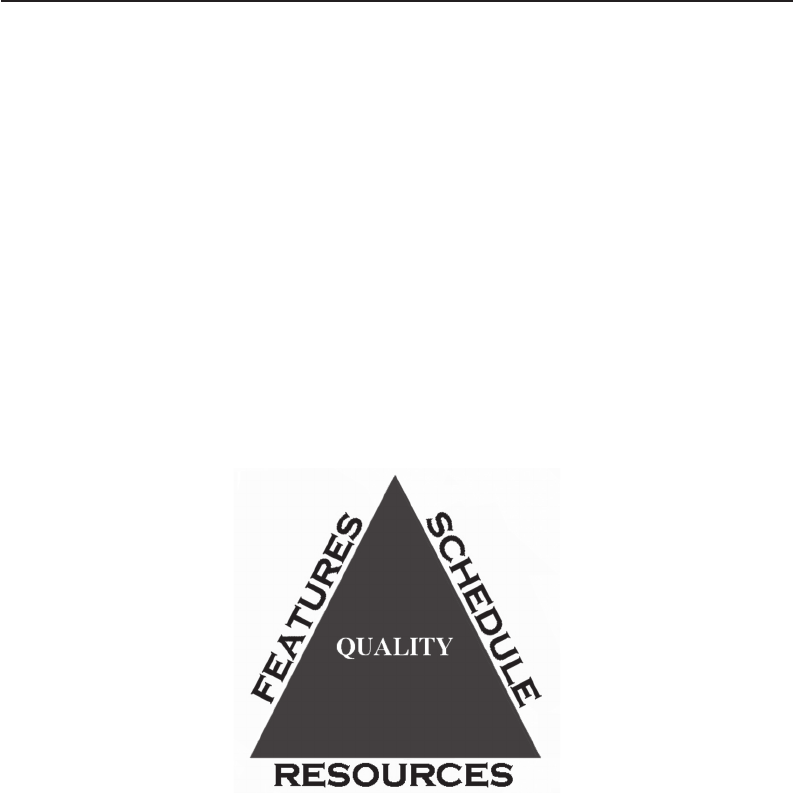
GAME PLAN
In This Chapter
• Dependencies
• Schedules
• Budgets
• Staffing
• Outsourcing
• Middleware
16.1 I
NTRODUCTION
A
fter the game requirements are determined, the game plan is created.
The game plan defines the following:
■
What work must be done.
■
What order the work is done.
■
Who will do the work.
■
When the work must be completed.
All the information generated during the requirements phase is needed in
order to make an accurate game plan. There are many useful project management
books that provide detailed information on creating project plans. Most of these
techniques are applicable to game development, although some modifications
might be necessary. Project Planning Scheduling and Control, Third Edition,
Chapter 16Chapter 16

262 THE GAME PRODUCTION HANDBOOK, 2/E
by Jim Lewis is recommended reading, as it provides practical and easy-to-
understand information about creating project plans and managing projects.
Keep in mind that the game requirements might change after the initial
game plan is completed. For example, the plan might show that the game will be
too expensive to make, and some of the requirements will need to be adjusted to
lower the cost. After the initial game plan is completed, expect to make changes
to it during production. In order to create a solid game plan, it is important to
understand the dependencies of the schedule, budget, and staffing plan.
16.2 DEPENDENCIES
If the budget, schedule, and staffing needs are not planned during pre-production,
you cannot manage these elements efficiently during the development process.
In some cases, the feature set of the game might need to change in order to
accommodate a change in schedule, such as a request by the publisher to ac-
celerate the release date. Therefore, factoring in the allotted time (schedule),
available staff and budget (resources), the feature set of the game (features), and
what quality is expected, such as next-generation graphics (quality), is extremely
important when putting together your game plan.
Figure 16.1 illustrates this dependency between the schedule, resources,
features, and quality. If one of these factors changes, it will affect the other three
factors. If all of these factors are constantly changing during the development
cycle, the project is never stable and is always at risk. One of the producer’s
biggest challenges while managing the game development process is striking
a balance between the schedule, resources, features, and quality. As stated
throughout this book, all development teams are different and never have the
exact same processes in place or risks to mitigate, but the producer’s ultimate
FIGURE 16.1 Dependencies among budget, schedule, and features.

GAME PLAN 263
WORKING WITH SMALL TEAMS
Paul Leska, President
Sapphire Software, Inc.
Our primary platform is cell phone games—all of us have other jobs, and cell
phone games are small enough for us to comfortably manage with a six to nine month
production cycle. We have a core team of three people, and if there is something we
don’t have experience in, we will usually subcontract the work. The principle roles are
roughly broken down to a producer role and technical director role, but we all do a va-
riety of tasks on the project, such as programming, working with testers, and working
with the publisher. We’ve found it is better for us to focus as a group on a single proj-
ect, instead of attempting multi-game development. If the team was larger and the
projects more lucrative, it would make more sense to have multi-game development.
When we start a new game, everyone will put together a list of the tasks that
need to be done on the game, and the producer-type will manage the process. The
level of ceremony goes up when the complexity of the game goes up. If we are
working on complex game we haven’t seen on the market before, we will do some
research and development and may create a prototype. Sometimes it is just a paper
prototype to find out if the rules make sense. Sometimes it is a flash prototype to
check out the buttons and screen layout function with a specific handset. If the pro-
totype is successful, we will create an iterative project plan. Development is done
in increments and incremental builds are sent to beta testers. This allows us to pin-
point problems earlier rather than later—it would delay the project significantly if
we waited until the game was at beta to test it on a phone, and find out that it did not
install correctly. This incremental testing also allows us to factor in any feedback.
In the past, we have tried to add another level of formality to the planning pro-
cess by having everyone one put together spreadsheets with core features. However,
pretty much everyone knows what they need to do on the game based on the pro-
totype, so planning, building a prototype, and then iterating on it is a good cycle for
us because of our staff size. If we had a larger team, we might do this more formal
process that includes defining the requirements and creating a game plan.
goal is still releasing a quality game on time and on (or under) budget. If the pro-
ducer carefully controls the balance among the schedule, budget, and staffing,
there is a much higher chance this goal can be achieved.
When working on schedules, budgets, and staffing plans, you must keep these
dependencies in mind at all times so your game plan is accurate. The schedule
is a good starting point, because a lot of information is generated during pre-
production that can easily translate into a robust schedule.
264 THE GAME PRODUCTION HANDBOOK, 2/E
16.3 SCHEDULES
A schedule lists each task to be completed, estimates of the task duration, who
is doing the task, and what tasks are dependent on the given tasks. Consider
using some type of scheduling software as this makes tracking the tasks easier.
Scheduling software enables the user to plug in new tasks and dates to see how
changes affect the overall schedule. Microsoft Project® is a popular scheduling
software that is useful in creating detailed schedules. Even if dates and deliver-
ables are shifting, the schedule’s basic task list will essentially stay the same unless
the feature is cut from the game. For example, the level-building section of the
schedule outlines each task needed to build a level. It might include creating a
concept, prototyping, building basic geometry, creating textures, polishing the
assets, and bug-fixing. The important thing to note is that even though dates may
change, the same tasks need to be completed.
Game development schedules can be extremely frustrating to create and
track. For one thing, feature creep runs rampant in game development, which
makes it difficult to create an initial schedule and use it throughout the game
development process. On a two-year development cycle, feature creep has a
huge impact; people will see a feature functioning in the game and figure there
is plenty of time to change or add functionality to make it better. This is why it is
helpful to schedule small milestones along the way, so you can keep better con-
trol of the features being implemented and additional feature requests.
When creating the game development schedule, there might be a tendency
to be overwhelmed by the thought of scheduling six months to two years worth of
work at the beginning of the project. How can anyone know all of the tasks that
need to be done? However, don’t let this prevent you from creating a useful sched-
ule as early in the development process as possible. Even if the schedule changes,
which it will, it is much better to have an initial baseline schedule of the estimated
work, than to have nothing to compare against the actual schedule changes. For ex-
ample, if there is no schedule and the publisher tells you the game has to ship three
months earlier, how will you know which tasks need to be cut from the schedule or
how many people need to be added to the team to accomplish this goal?
Involve the entire team in creating the schedule. Generally, if people are
just told to complete all their work by a specific deadline, with no explanation on
how this date was determined or why this date is important to the project, they
are less likely to take the date seriously. Because they don’t have full knowledge
of what the impact is when they miss their deadlines, they might treat the due
date as more of a guideline than a deadline. When this happens, the schedule
can quickly get out of control.
If the team is involved in creating the schedule, they have more ownership
over their tasks and treat the deadlines more seriously. Also, each person best
understands how much work he can accomplish in a day and can better inform

GAME PLAN 265
you how long it will take them to complete each of their assigned tasks. They
are also able to point out areas where critical tasks are missing and identify high,
medium, and low risk areas on the schedule.
Creating a Schedule
Creating a schedule will take some time, especially during pre-production when
many game elements are not final. The producer can expect to spend several
days or even weeks putting together a complete schedule and will continue to
update it throughout production. Although time-consuming, a schedule is not
too difficult to put together as long as you stay focused on the actual tasks to be
completed. Avoid creating a schedule based on what you think needs to be done,
instead of what actually needs to be done.
One way to properly determine which tasks to complete is to determine exit
criteria. Exit criteria are a pre-defined set of conditions that must be fulfilled
before a task is deemed completed. Exit criteria mainly consist of tangible as-
sets that are easily defined. For example, the exit criteria for the concept phase
includes the following:
■
Initial concept
■
Competitive analysis
■
Pitch presentation
■
Risk analysis
■
Concept approval
■
Project kick-off
When all of these deliverables are completed, the concept phase is fully
complete. Involve the team in determining exit criteria for each phase of pro-
duction, with the final exit criteria being an approved gold master that can be
manufactured and shipped to stores.
CREATING AN ART SCHEDULE
Carey Chico, Art Director
Pandemic Studios
The art director and lead artist will be able to provide estimates for each art
task and define what the final deliverables will be for each task. As you create the art
schedule, break down the tasks into smaller tasks that can be assigned to individual
artists. In addition, it is helpful if you schedule groups of artists to work on similar
assets and appoint someone as the point of contact for this group. For example, you
could have one group working on all the character and vehicle models on the game
and another group working on all the Havok destructible objects in the game.
..................Content has been hidden....................
You can't read the all page of ebook, please click here login for view all page.
